
The Fuller Building is a skyscraper at 57th Street and Madison Avenue in the Midtown Manhattan neighborhood of New York City. Designed by Walker & Gillette, it was erected between 1928 and 1929. The building is named for its original main occupant, the Fuller Construction Company, which moved from the Flatiron Building.

1 William Street is an office building in the Financial District of Lower Manhattan in New York City. The building has had a number of names, originally the J. & W. Seligman & Company Building, and later the Lehman Brothers Building. Currently it is also known as the Banca Commerciale Italiana Building.
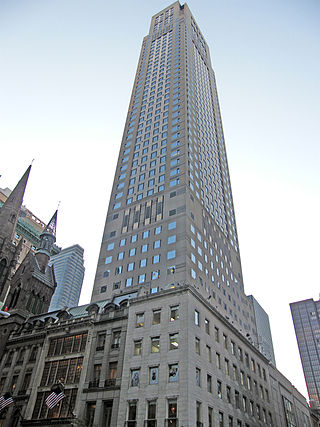
712 Fifth Avenue is a 650-foot-tall (200 m) skyscraper at 56th Street and Fifth Avenue in the Midtown Manhattan neighborhood of New York City. Constructed from 1987 to 1990, it was designed by SLCE Architects and Kohn Pedersen Fox Associates. The skyscraper's base includes the Coty Building at 714 Fifth Avenue and the Rizzoli Bookstore building at 712 Fifth Avenue, both of which are New York City designated landmarks.

The Scribner Building is a commercial structure at 155 Fifth Avenue, near 21st Street, in the Flatiron District of Manhattan in New York City. Designed by Ernest Flagg in the Beaux Arts style, it was completed in 1893 as the corporate headquarters of Charles Scribner's Sons publishing company.

3 East 57th Street, originally the L. P. Hollander Company Building, is a nine-story commercial building in the Midtown Manhattan neighborhood of New York City. It is along the northern side of 57th Street, just east of Fifth Avenue. 3 East 57th Street, constructed from 1929 to 1930, was designed by Shreve, Lamb & Harmon in an early Art Deco style.

The William H. Moore House, also known as the Stokes-Moore Mansion and 4 East 54th Street, is a commercial building in the Midtown Manhattan neighborhood of New York City. It is along 54th Street's southern sidewalk between Madison Avenue and Fifth Avenue. The building was designed by McKim, Mead & White and constructed between 1898 and 1900 as a private residence.

The Ritz Tower is a luxury residential building at 465 Park Avenue on the corner of East 57th Street in the Midtown Manhattan neighborhood of New York City. It was built from 1925 to 1926 as an apartment hotel and was designed by Emery Roth and Thomas Hastings for journalist Arthur Brisbane, who was the developer. The Ritz Tower is about 541 feet (165 m) with 41 stories, making it the tallest residential building in New York City upon its completion. Because it was initially classified as an apartment hotel, the building was constructed to a greater height than was usually permitted.

218 West 57th Street is a building on 57th Street in Midtown Manhattan in New York City. It was designed by Cyrus L. W. Eidlitz in the French Renaissance Revival style, with an annex built to designs by Eidlitz and Andrew C. McKenzie. The building served as the headquarters of the American Society of Civil Engineers (ASCE) from 1897 to 1917.

130 West 57th Street is an office building on 57th Street between Sixth Avenue and Seventh Avenue in Midtown Manhattan in New York City. It was built from 1907 to 1908 and designed by Pollard and Steinam, who also simultaneously designed the neighboring, nearly identical building at 140 West 57th Street. The buildings are among several in Manhattan that were built in the early 20th century as both studio and residences for artists.
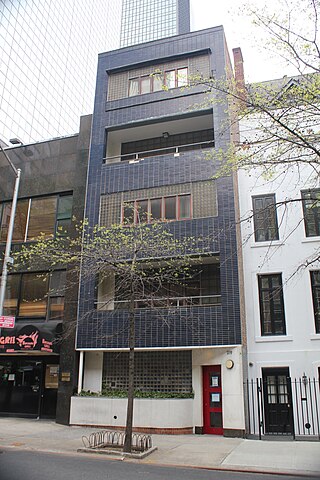
219 East 49th Street, also known as the Morris B. Sanders Studio & Apartment, is a building in the East Midtown and Turtle Bay neighborhoods of Manhattan in New York City, along the northern sidewalk of 49th Street between Second Avenue and Third Avenue. The house, designed by Arkansas architect Morris B. Sanders Jr. and constructed in 1935, replaced a 19th-century brownstone townhouse. It contained Sanders's studio, as well as a residence for him and his wife Barbara Castleton Davis.

689 Fifth Avenue is a commercial building in the Midtown Manhattan neighborhood of New York City, at the northeast corner of Fifth Avenue and 54th Street. The building was designed by Warren and Wetmore and constructed from 1925 to 1927.

13 and 15 West 54th Street are two commercial buildings in the Midtown Manhattan neighborhood of New York City. They are along 54th Street's northern sidewalk between Fifth Avenue and Sixth Avenue. The four-and-a-half-story houses were designed by Henry Janeway Hardenbergh in the Renaissance-inspired style and were constructed between 1896 and 1897 as private residences. They are the two westernmost of five consecutive townhouses erected along the same city block during the 1890s, the others being 5, 7, and 9–11 West 54th Street.
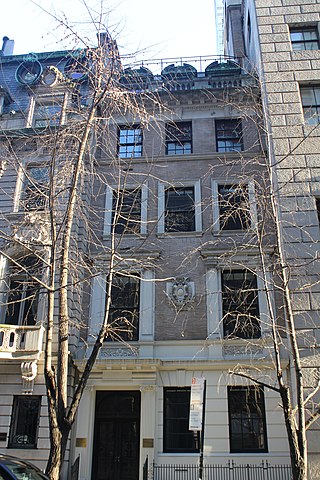
5 West 54th Street is a commercial building in the Midtown Manhattan neighborhood of New York City. It is along 54th Street's northern sidewalk between Fifth Avenue and Sixth Avenue. The four-story building was designed by R. H. Robertson in the Italian Renaissance Revival style and was constructed between 1897 and 1899 as a private residence. It is the easternmost of five consecutive townhouses erected along the same city block during the 1890s, the others being 7, 11, 13 and 15 West 54th Street. The first floor is clad with rusticated blocks of limestone, while the other floors contain buff-colored brick trimmed with limestone.
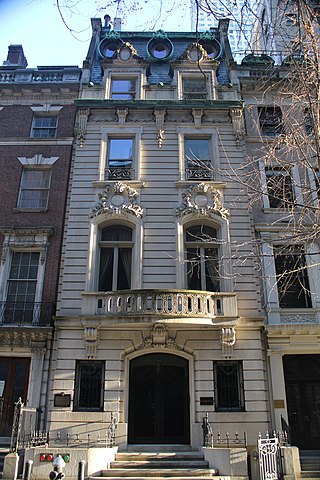
7 West 54th Street is a commercial building in the Midtown Manhattan neighborhood of New York City. It is along 54th Street's northern sidewalk between Fifth Avenue and Sixth Avenue. The four-story building was designed by John H. Duncan in the French Beaux-Arts style and was constructed between 1899 and 1900 as a private residence. It is one of five consecutive townhouses erected along the same city block during the 1890s, the others being 5, 11, and 13 and 15 West 54th Street.

The Rockefeller Apartments is a residential building at 17 West 54th Street and 24 West 55th Street in the Midtown Manhattan neighborhood of New York City. Designed by Wallace Harrison and J. André Fouilhoux in the International Style, the Rockefeller Apartments was constructed between 1935 and 1936. The complex was originally designed with 138 apartments.

10 West 56th Street is a commercial building in the Midtown Manhattan neighborhood of New York City. It is along 56th Street's southern sidewalk between Fifth Avenue and Sixth Avenue. The six-story building was designed by Warren and Wetmore in the French Renaissance Revival style. It was constructed in 1901 as a private residence, one of several on 56th Street's "Bankers' Row".
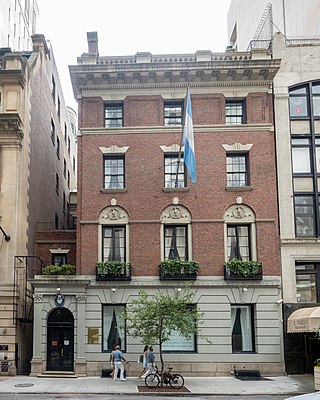
12 West 56th Street is a consular building in the Midtown Manhattan neighborhood of New York City, housing the Consulate General of Argentina in New York City. It is along 56th Street's southern sidewalk between Fifth Avenue and Sixth Avenue. The four-and-a-half story building was designed by McKim, Mead & White in the Georgian Revival style. It was constructed between 1899 and 1901 as a private residence, one of several on 56th Street's "Bankers' Row".

46 West 55th Street is a commercial building in the Midtown Manhattan neighborhood of New York City. It is along the south side of 55th Street between Fifth Avenue and Sixth Avenue. The five-story building was designed by Thomas Thomas in the Italianate style and was constructed in 1869. It was redesigned in the neoclassical style between 1903 and 1904 by Edward L. Tilton. As redesigned by Tilton, the first floor contains a limestone entrance, while the other floors contain red and black brick with limestone moldings. The first four stories are bowed slightly outward.

12 East 53rd Street, also the Fisk–Harkness House, is a building in the Midtown Manhattan neighborhood of New York City. It is along the south side of 53rd Street between Madison Avenue and Fifth Avenue. The six-story building was designed by Griffith Thomas and was constructed in 1871. It was redesigned in the Tudor-inspired Gothic Revival style in 1906 by Raleigh C. Gildersleeve.

56 Beaver Street is a structure in the Financial District of Manhattan in New York City, United States. Designed by James Brown Lord, the building was completed in 1891 as a location of the Delmonico's restaurant chain. The current building, commissioned by Delmonico's chief executive Charles Crist Delmonico, replaced Delmonico's first building on the site, which had been built in 1837. The building is a New York City designated landmark and a contributing property to the Wall Street Historic District, a National Register of Historic Places district.

























